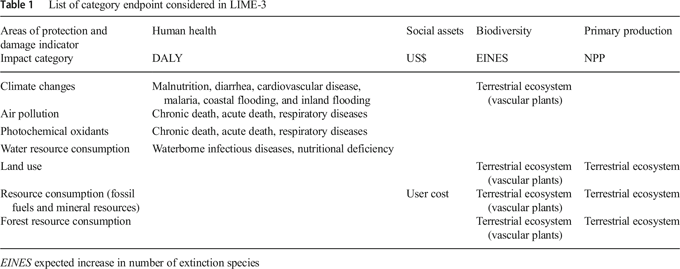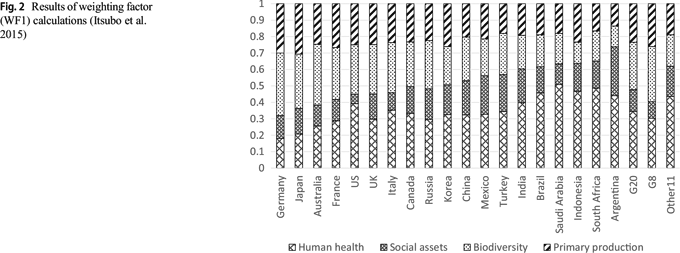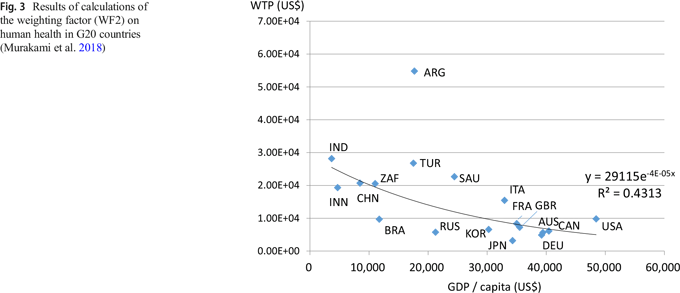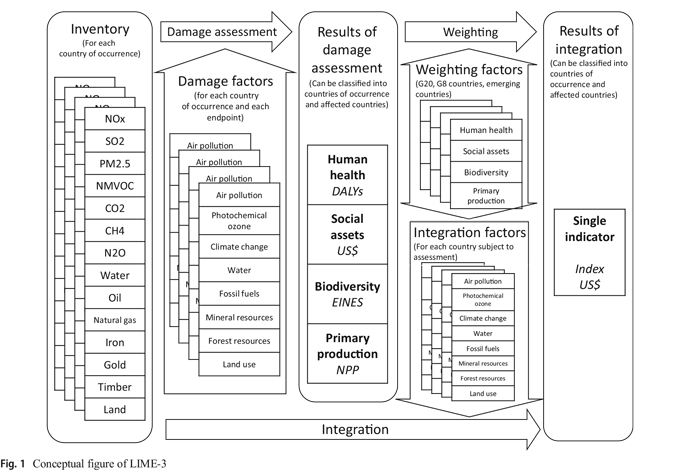- HOME
- > English Top
- > LIME
LCA Society of Japan
LIME
LIME2
JLCA Newsletter<LIME2 Library>
LIME3
Source:
Inaba, A. & Itsubo, N. Int J Life Cycle Assess (2018) 23: 2271.
https://doi.org/10.1007/s11367-018-1545-6
The first version of LIME, LIME-1, was developed in 2000 by the Japanese national project of LCA on 1998–2000 supported by METI (Ministry of Economy, Trade and Industry), when the basic methodology of LIME was established. LIME has three steps of LCIA (characterization, damage assessment, and weighting) and conjoint analysis was used for the weighting.
LIME-1 had 11 impact categories for characterization (air pollution, human toxicity, ozone layer depletion, global warming, ecotoxicity, acidification, eutrophication, ozone creation, land use, solid waste, and resource consumption) and 4 endpoints (human health, social assets, biodiversity, and primary production).LIME-2 was developed by the 2nd National Project of LCA on 2004–2006, where indoor air pollution and noise were added for the characterization and the conjoint analysis was conducted by almost 1000 respondents of all Japan. LIME-1 and LIME-2 reflected the environmental conditions in Japan and the environmental thoughts of the Japanese people; therefore, it was not suitable for assessing the environmental impacts in other countries/regions (Itsubo and Inaba 2012; Itsubo et al. 2012, Itsubo et al. 2015).
LIME-3 was developed in 2016, where the methodology of LIME-1 and LIME-2 was expanded in order to be used in the world. For characterization, nine impact categories (climate change, air pollution, photochemical oxidants creation, water consumption, land use, mineral resource consumption, fossil fuel consumption, forest resource consumption, and solid waste) were selected and four endpoints (human health, social assets, biodiversity, and primary production) were the same as LIME-1 and LIME-2. The conjoint analysis for weighting was conducted in all G20 countries.
Figure 1 shows the basic structure of LIME-3 and Table 1 shows the relationship between the impact categories and the endpoints. The unshaded columns of Table 1 were calculated by LIME-3. For example, the health damage of climate change includes malaria, cardiovascular disease, disaster, malnutrition, and diarrhea. The light-shaded columns were judged after consideration to have a small impact. On the other hand, those in the dark-shaded columns are likely to have a significant impact, but their calculations were difficult even with the latest knowledge in each research field.
As shown Table 1, for climate change, its impact on both human health and biodiversity was calculated. Concerning the impact on human health, the quantity of damage from CO2 emissions was calculated for each disease (malnutrition,diarrhea, cardiovascular disease, malaria, coastal flooding, and inland flooding). It was found that a greater impact was made by malnutrition (26.8 × 10–8 years/kgCO2) and diarrhea (9.0 × 10–8 year/kgCO2), secondary disasters that were not taken into account in previous studies, than by the direct impact of temperature changes (cardiovascular disease (0.4 × 10–8 years/kgCO2)). The details of the methodology and result of damage factors caused by climate change were described by Tang et al. (2018a). Damage to biodiversity caused by climate change was assessed by analyzing the changes in
the vegetation distribution of 250 species of plants in Japan. The analyses were made by using a statistical model, and the length of time before extinction was thus calculated (Tang et al. 2018b). Further, combined with the risk of extinction on the continental scale, these results were used to expand the calculation to a global scale.
Regarding the damage model of air pollutants (SO2, NO2, black carbon, and organic carbon) (Tang et al. 2018c) and photochemical oxidant substances (Tang et al. 2018d), transboundary effects have been taken into account with the application of a global chemical transport model. LIME-3 involves analyses of both the region from where the pollutant is emitted and other regions where the damages occurred, enabling the avoidance of underestimations.
In LIME-3, water use was included as a new impact category to develop a method of assessing the impact on health. The expected value for the number of people with health damage caused by the consumption of freshwater was calculated for each country by conducting a multiple linear regression analysis based on statistical data on each country of the world. It was found that the damage quantity is greater in developing countries with serious water shortages than in developed countries. Damage factors related with water use were described by Motoshita et al. (2018).
A method of assessing damage to biodiversity and primary production caused by land use was developed. A method of
assessing the increment in the risk of the extinction of vascular plants in Japan that would be caused by land transformation was developed, and analyses of 2000 species were made. The representative value for damage factors in Japan was calculated by undertaking an analysis for each type of land use, and then damage factors expanded to 193 countries around the world were developed by using data from IUCN. Yamaguchi et al. (2018) described the method and damage factors related with biodiversity caused by land use.
A method of assessing damage from resource consumption was developed for each endpoint (social assets, primary production, and biodiversity). The area of land that was transformed as a result of mining was calculated for each resource and each country in consideration of the grades of resources and the mining methods. Damage factors reflecting the environmental conditions of the mining country were calculated by using the data on the number of endangered species and the amount of primary production in the country. The reflection of trades between consumer countries and mining countries enabled the establishment of a method that enables an analysis of the damage to the mining country caused by the consumption of a unit of resources in the consumer country.
In terms of weighting, a questionnaire survey of all the G20 member countries was conducted. An interview survey (doorto-door survey/central location survey) was conducted for emerging 11 countries, giving priority to respondents’ understanding of the survey sheet’s content and minimization of their bias. For developed countries, an internet survey was adopted after confirming the result of the pretest that the difference between the results of the internet survey and the interview survey was small. Random sampling was adopted for both surveys, and 200 to 250 samples were taken from each emerging country and 500 to 600 from each developed country. A total of 6400 responses were obtained. The difference in environmental awareness between individuals was examined by using the random parameter logit model.
Two types of weighting factors—non-dimensional weighting factor (WF1) and economic weighting factors using willingness to pay (WF2)—were obtained. Figure 2 shows the results of the calculation of the weighting factors (WF1) of all the G20 countries, developed countries (G8), emerging countries (G20 countries excluding G8), and each G20 member country, which were made non-dimensional so that the sum of the weights of the four items would be 1.Among developed countries (G8), values for biodiversity and primary production are higher than among G20 countries. On the other hand, the weight of human health (0.44) is especially heavy in emerging
countries, while the weights of the three other items are almost equal to each other (0.18 for social assets, 0.19 for biodiversity, and 0.19 for primary production). The weighting factors of the respective countries do not differ significantly among developed countries, but vary greatly among emerging countries.
Figure 3 shows the economic weighting factors of human health (US$/1 year-DALY) using willingness to pay (WF2) in each country, which were higher in emerging countries than those in developed countries. These results were almost the same in the other three endpoints although their absolute values were different. It might be caused by the circumstances that the environmental problems are more serious in emerging countries than developed countries. It should be reflected by environmental awareness in G20 countries. The details are shown by Itsubo et al. (2018b) and Murakami et al. (2018).

As described above, while LIME-3 covers nine areas, including climate change and air pollution, it cannot be said that the range of categories is wide enough compared to other LCIA methods. For the development of damage factors concerning ecotoxicity and human toxicity, eutrophication, acidification, and noise are needed for the global scale assessment.
Also in terms of weighting, the weighting factors of G20 countries were calculated in LIME-3, but the surveys for developing countries should be conducted. In our experience, the survey sheet for conjoint analysis is not sufficiently understood in developing countries. Weighting factors representing the entire world, including developing countries, need to be developed in the future.


Buwal (1998) Bewertung in Ökobilanzen mit der Methode der Ökologischen Knappheit, Ökofactoren 1997, BUWAL (1998) Available online at https://www.tib.eu. Accessed 26 Oct 2018
Goedkoop M (1995) The Eco-indicator 95. NOH report 9523. PRé Consultants, Amersfoort, Available online at https://www.pre-sustainability.com. Accessed 26 Oct 2018
Goedkoop M, Spriensma R (2000) The Eco-indicator 99, a damage oriented method for life cycle impact assessment, Methodology Report 2nd edition, Available online at https://www.pre-sustainability.com. Accessed 26 Oct 2018
Goedkoop M, Heijungs R, Huibregts M, Schryver AD, Struijs J, van ZelmR (2009) ReCiPe 2008,Alife cycle impact assessmentmethod which comprises harmonised category indicators at the midpoint and endpoint level, First edition Report I: characterization, first edition,6 January 2009, Available online at https://www.pre-sustainability.com. Accessed 26 Oct 2018
Huijbregts MAJ, Steinmann ZJN, Elshout PMF, Stam G, Verones F,Vieira MDM, Hollander A, Zijp M, van Zelm R (2016) ReCiPe 2016: a harmonized life cycle impact assessment method at midpoint and endpoint level Report I: Characterization, http://www.rivm.nl/en/Documents_and_publications/Scientific/Reports/2016/december/ReCiPe_2016_A_harmonized_life_cycle_
impact_assessment_method_at_midpoint_and_endpoint_level_Report_I_Characterization,. Accessed 26 Oct 2018
ISO/CD 14007 (2018) Environmental management: determining environmental costs and benefits – Guidance, Available online at https://committee.iso.org ISO/DIS 14008 (2018)Monetary valuation of environmental impacts and related environmental aspects, Available online at https://committee.iso.org
ISO/NP 14097 (2018) Framework and principles for assessing and reporting investments and financing activities related to climate change, Available online at https://committee.iso.org. Accessed 26 Oct 2018
Itsubo N, Inaba A (2012) LIME2 life cycle impact assessment method based on endpoint modeling, LCA news letter, No.14, Available online at https://lca-forum.org. Accessed 26 Oct 2018
Itsubo, N., Sakagami, M., Kuriyama, K. et al. (2012) Int J Life Cycle Assess 17: 488. https://doi.org/10.1007/s11367-012-0379-x
Itsubo, N., Murakami, K., Kuriyama, K. et al. (2015) Int J Life Cycle Assess . https://doi.org/10.1007/s11367-015-0881-z (this issue)
MotoshitaM, Ono Y, Pfister S, Boulay A, Berger M, Nansai K, Tahara K, Itsubo N, Inaba A (2018) Consistent characterisation factors at midpoint and endpoint relevant to agricultural water scarcity arising from freshwater consumption. Int J Life Cycle Assess. https://doi.org/10.1007/s11367-014-0811-5 (this issue)
Murakami, K., Itsubo, N., Kuriyama, K. et al. Int J Life Cycle Assess(2018). https://doi.org/10.1007/s11367-017-1372-1 (this issue)
Steen B (1999) A systematic approach to Environmental Priority Strategies in product development (EPS). Version 2000-Models and Data of the Default Method, Chalmers University of Technology, Available online at https://pdfs.semanticscholar.org. Accessed 26 Oct 2018
Tang L, Ii R, Tokimatsu K, Itsubo N (2018a) Development of human health damage factors related to CO2 emissions by considering future socioeconomic scenarios. Int J Life Cycle Assess. https://doi.org/10.1007/s11367-015-0965-9 (this issue)
Tang L, Higa M, Tanaka N, Itsubo N (2018b) Assessment of global warming impact on biodiversity using the extinction risk index in LCIA: a case study of Japanese plant species. Int J Life Cycle Assess. https://doi.org/10.1007/s11367-017-1319-6 (this issue)
Tang L, Nagashima T, Hasegawa K, Ohara T, Sudo K, Itsubo N (2018c) Development of human health damage factors for PM2.5 based on a global chemical transport model. Int Life Cycle Assess. https://doi.org/10.1007/s11367-014-0837-8 (this issue)
Tang L, Nagashima T, Hasegawa K, Ohara T, Sudo K, Itsubo N (2018d) Development of human health damage factors for tropospheric ozone considering transboundary transport on a global scale. Int J Life Cycle Assess. https://doi.org/10.1007/s11367-015-1001-9 (thisissue)
TFCD (2018) Task Force on Climate-Related Financial Disclosures, https://www.fsb-tcfd.org/, (2018-08-20)
Yamaguchi K, Ii R, Itsubo N (2018) Ecosystem damage assessment of land transformation using species loss. Int J Life Cycle Assess. https://doi.org/10.1007/s11367-016-1072-2 (this issue)
Eight articles introducing methodologies adapted in LIME3 have been published in International Journal of Life Cycle Assessment.
Download here,
https://link.springer.com/journal/11367/23/12
1. Preface
Atsushi Inaba, Norihiro Itsubo
Pages 2271-2275
2. Consistent characterisation factors at midpoint and endpoint relevant to agricultural water scarcity arising from freshwater consumption
Masaharu Motoshita, Yuya Ono, Stephan Pfister, Anne-Marie Boulay, Markus Berger, Keisuke Nansai, Kiyotaka Tahara, Norihiro Itsubo, Atsushi Inaba
Pages 2276-2287
3. Development of human health damage factors related to CO2 emissions by considering future socioeconomic scenarios
Longlong Tang, Ryouta Ii,Koji Tokimatsu, Norihiro Itsubo
Pages 2288-2299
4. Development of human health damage factors for PM2.5 based on a global chemical transport model
Longlong Tang, Tatsuya Nagashima, Kouichi Hasegawa, Toshimasa Ohara, Kengo Sudo, Norihiro Itsubo
Pages 2300-2310
5. Development of weighting factors for G20 countries—explore the difference in environmental awareness between developed and emerging countries
Norihiro Itsubo, Kayo Murakami, Koichi Kuriyama, Kentaro Yoshida, Koji Tokimatsu, Atsushi Inaba
Pages 2311-2326
6. Ecosystem damage assessment of land transformation using species loss
Kazuko Yamaguchi, Ryota Ii, Norihiro Itsubo
Pages 2327-2338
7. Development of human health damage factors for tropospheric ozone considering transboundary transport on a global scale
Longlong Tang, Tatsuya Nagashima, Kouichi Hasegawa, Toshimasa Ohara, Kengo Sudo, Norihiro Itsubo
Pages 2339-2348
8. DEVELOPMENT OF GLOBAL SCALE LCIA METHOD
Development of weighting factors for G20 countries. Part 2: estimation of willingness to pay and annual global damage cost
Kayo Murakami, Norihiro Itsubo, Koichi Kuriyama, Kentaro Yoshida, Koji Tokimatsu
Pages 2349-2364
・LIME3 Coefficient List
・LIME3 case studies
case1. Taiheiyo Cement Corporation
case2. Sekisui Chemical Co., Ltd.
case3. Shiseido Company, Limited
case4. Nissan Motor Co., Ltd.
case5. Sun Messe Co., Ltd.

- LCA Society of Japan
-
- Membership Access
-
For Access to JLCA Database
-

- LCA Society of Japan
- LIME
- JLCA Newsletter<LIME2 Library>
- LIME3 case studys
Preface
case1. Taiheiyo Cement Corporation
case2. Sekisui Chemical Co., Ltd.
case3. Shiseido Company, Limited
case4. Nissan Motor Co., Ltd.
case5. Sun Messe Co., Ltd.
- LCA Project (FY2003-FY2005)
- LCA Project (FY1998-FY2002)
- JLCA Newsletter
- ECO Efficiency

